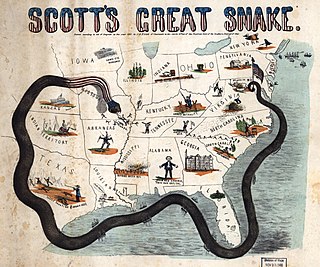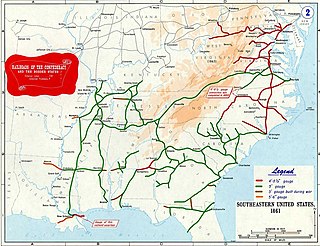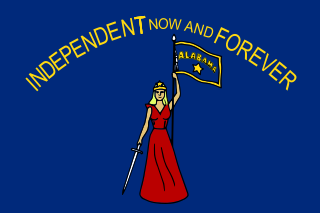Related Research Articles

The American Civil War was a civil war in the United States between the Union and the Confederacy, which was formed in 1861 by states that had seceded from the Union. The central conflict leading to war was a dispute over whether slavery should be permitted to expand into the western territories, leading to more slave states, or be prohibited from doing so, which many believed would place slavery on a course of ultimate extinction.

The Confederate States of America (CSA), commonly referred to as the Confederate States (C.S.), the Confederacy, or the South, was an unrecognized breakaway republic in the Southern United States that existed from February 8, 1861, to May 5, 1865. It was composed of eleven U.S. states that declared secession; South Carolina, Mississippi, Florida, Alabama, Georgia, Louisiana, Texas, Virginia, Arkansas, Tennessee, and North Carolina. These states warred against the United States during the American Civil War.

The Union, colloquially known as the North, refers to the United States when eleven Southern slave states seceded to form the Confederate States of America (CSA), also known as the Confederacy or South, during the American Civil War. The Union was led by Abraham Lincoln, the 16th president of the United States, and sought to preserve the nation, a constitutional federal union.

Edmund Kirby Smith was a Confederate States Army general, who oversaw the Trans-Mississippi Department from 1863 to 1865. Before the American Civil War, Smith served as an officer of the United States Army.
Cotton diplomacy was the attempt by the Confederacy during the American Civil War to coerce Great Britain and France to support the Confederate war effort by implementing a cotton trade embargo against Britain and the rest of Europe. The Confederacy believed that both Britain and France, who before the war depended heavily on Southern cotton for textile manufacturing, would support the Confederate war effort if the cotton trade were restricted. Ultimately, cotton diplomacy did not work in favor of the Confederacy, as European nations largely sought alternative markets to obtain cotton. In fact, the cotton embargo transformed into a self-embargo which restricted the Confederate economy. Ultimately, the growth in the demand for cotton that fueled the antebellum economy did not continue.

The Union blockade in the American Civil War was a naval strategy by the United States to prevent the Confederacy from trading.

The American Civil War was the first conflict where large armies heavily relied on railroads for transporting supplies. The Confederate States Army's railroad system was fragile and primarily designed for short hauls of cotton to nearby rivers or ocean port. Due to the South's limited manufacturing and industrial capacity, obtaining new parts during the war was challenging. Consequently, the railroad system deteriorated due to overuse, lack of maintenance, and systematic destruction by Union raiders.
"King Cotton" is a slogan that summarized the strategy used before the American Civil War by secessionists in the southern states to claim the feasibility of secession and to prove there was no need to fear a war with the northern states. The theory held that control over cotton exports would make a proposed independent Confederacy economically prosperous, would ruin the textile industry of New England, and—most importantly—would force the United Kingdom and perhaps France to support the Confederacy militarily because their industrial economies depended on Southern cotton.
The Confederate States of America (1861–1865) started with an agrarian-based economy that relied heavily on slave-worked plantations for the production of cotton for export to Europe and to the Northern US. If classed as an independent country, the area of the Confederate States would have ranked as the fourth-richest country of the world in 1860. But, when the Union began its blockade of Confederate ports in the summer of 1861, exports of cotton fell 95% and the South had to restructure itself to emphasize the production of food and munitions for internal use. After losing control of its main rivers and ports, the Confederacy had to depend on a delicate railroad system for transport that, with few repairs being made, no new equipment, and destructive raids, crumbled away. The financial infrastructure collapsed during the war as inflation destroyed banks and forced a move toward a barter economy for civilians. The Confederate government seized needed supplies and livestock. By 1865, the Confederate economy was in ruins.
The Confederate Secret Service refers to any of a number of official and semi-official secret service organizations and operations performed by the Confederate States of America during the American Civil War. Some of the organizations were directed by the Confederate government, others operated independently with government approval, while still others were either completely independent of the government or operated with only its tacit acknowledgment.

Josiah Gorgas was a Confederate general in the American Civil War and was later president of the University of Alabama.

Alabama was central to the Civil War, with the secession convention at Montgomery, the birthplace of the Confederacy, inviting other slaveholding states to form a southern republic, during January–March 1861, and to develop new state constitutions. The 1861 Alabaman constitution granted citizenship to current U.S. residents, but prohibited import duties (tariffs) on foreign goods, limited a standing military, and as a final issue, opposed emancipation by any nation, but urged protection of African-American slaves with trials by jury, and reserved the power to regulate or prohibit the African slave trade. The secession convention invited all slaveholding states to secede, but only 7 Cotton States of the Lower South formed the Confederacy with Alabama, while the majority of slave states were in the Union at the time of the founding of the Confederacy. Congress had voted to protect the institution of slavery by passing the Corwin Amendment on March 4, 1861, but it was never ratified.

Texas declared its secession from the Union on February 1, 1861, and joined the Confederate States on March 2, 1861, after it had replaced its governor, Sam Houston, who had refused to take an oath of allegiance to the Confederacy. As with those of other states, the Declaration of Secession was not recognized by the US government at Washington, DC. Some Texan military units fought in the Civil War east of the Mississippi River, but Texas was more useful for supplying soldiers and horses for the Confederate Army. Texas' supply role lasted until mid-1863, when Union gunboats started to control the Mississippi River, which prevented large transfers of men, horses, or cattle. Some cotton was sold in Mexico, but most of the crop became useless because of the Union's naval blockade of Galveston, Houston, and other ports.

New Orleans, Louisiana, was the largest city in the South, providing military supplies and thousands of troops for the Confederate States Army. Its location near the mouth of the Mississippi made it a prime target for the Union, both for controlling the huge waterway and crippling the Confederacy's vital cotton exports.
At the end of the American Civil War, the devastation and disruption in the state of Georgia were dramatic. Wartime damage, the inability to maintain a labor force without slavery, and miserable weather had a disastrous effect on agricultural production. The state's chief cash crop, cotton, fell from a high of more than 700,000 bales in 1860 to less than 50,000 in 1865, while harvests of corn and wheat were also meager. The state government subsidized construction of numerous new railroad lines. White farmers turned to cotton as a cash crop, often using commercial fertilizers to make up for the poor soils they owned. The coastal rice plantations never recovered from the war.
The United Kingdom of Great Britain and Ireland remained officially neutral throughout the American Civil War (1861–1865). It legally recognized the belligerent status of the Confederate States of America (CSA) but never recognized it as a nation and neither signed a treaty with it nor ever exchanged ambassadors. Over 90 percent of Confederate trade with Britain ended, causing a severe shortage of cotton by 1862. Private British blockade runners sent munitions and luxuries to Confederate ports in return for cotton and tobacco. In Manchester, the massive reduction of available American cotton caused an economic disaster referred to as the Lancashire Cotton Famine. Despite the high unemployment, some Manchester cotton workers refused out of principle to process any cotton from America, leading to direct praise from President Lincoln, whose statue in Manchester bears a plaque which quotes his appreciation for the textile workers in "helping abolish slavery". Top British officials debated offering to mediate in the first 18 months, which the Confederacy wanted but the United States strongly rejected.

The Second French Empire remained officially neutral throughout the American Civil War and never recognized the Confederate States of America. The United States warned that recognition would mean war. France was reluctant to act without British collaboration, and the British government rejected intervention.

During the American Civil War, blockade runners were used to get supplies through the Union blockade of the Confederate States of America that extended some 3,500 miles (5,600 km) along the Atlantic and Gulf of Mexico coastlines and the lower Mississippi River. The Confederacy had little industrial capability and could not produce the quantity of arms and other supplies needed to fight against the Union. To meet this need, British investors financed numerous blockade runners that were constructed in the British Isles and were used to import the guns, ordnance and other supplies, in exchange for cotton that the British textile industry needed greatly. To penetrate the blockade, these relatively lightweight shallow draft ships, mostly built in British shipyards and specially designed for speed, but not suited for transporting large quantities of cotton, had to cruise undetected, usually at night, through the Union blockade. The typical blockade runners were privately owned vessels often operating with a letter of marque issued by the Confederate government. If spotted, the blockade runners would attempt to outmaneuver or simply outrun any Union Navy warships on blockade patrol, often successfully.

The diplomacy of the American Civil War involved the relations of the United States and the Confederate States of America with the major world powers during the American Civil War of 1861–1865. The United States prevented other powers from recognizing the Confederacy, which counted heavily on Britain and France to enter the war on its side to maintain their supply of cotton and to weaken a growing opponent. Every nation was officially neutral throughout the war, and none formally recognized the Confederacy.
S. Isaac, Campbell & Company in London started out as a boot manufacturer for the British military and later became one of the largest suppliers of arms and military wares to the Confederacy during most of the American Civil War. Before the war the firm handled large contracts for the British military, but after a corruption scandal it lost its privilege of doing any sort of business with the British government. The company then turned to supplying British militia, and then to the desperate Confederacy, which quickly became their largest customer. Confederate business and purchases of arms in Britain was conducted mostly by Confederate Major Caleb Huse, and his associate Major James Bulloch who acted as chief purchasing agents and diplomats for the Confederacy. Ultimately, it was the Confederacy's enormous debt to Isaac, Campbell & Company that was the primary cause of the company's ruin.
References
- ↑ “Bureau of Foreign Supplies and the Crenshaw Line.” Confederate Industry: Manufacturers and Quartermasters in the Civil War, by Harold S. Wilson, University Press of Mississippi, 2005, pp. 176–178.In-text Citation
- ↑ “Securing a Separate Identity.” Texas in the Confederacy an Experiment in Nation Building, by Clayton E. Jewett, University of Missouri Press, 2002, pp. 192–197.In-text Citation